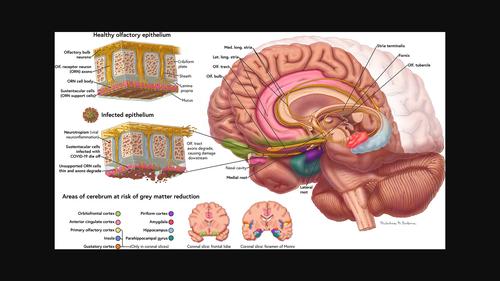当前位置:
X-MOL 学术
›
Neuropathol. Appl. Neurobiol.
›
论文详情
Our official English website, www.x-mol.net, welcomes your feedback! (Note: you will need to create a separate account there.)
Mechanisms of COVID‐19‐associated olfactory dysfunction
Neuropathology and Applied Neurobiology ( IF 5 ) Pub Date : 2024-02-29 , DOI: 10.1111/nan.12960 Koping Chang, Thomas Zaikos, Nicholas Kilner‐Pontone, Cheng‐Ying Ho
Neuropathology and Applied Neurobiology ( IF 5 ) Pub Date : 2024-02-29 , DOI: 10.1111/nan.12960 Koping Chang, Thomas Zaikos, Nicholas Kilner‐Pontone, Cheng‐Ying Ho

|
Olfactory dysfunction is one of the most common symptoms of COVID‐19. In the first 2 years of the pandemic, it was frequently reported, although its incidence has significantly decreased with the emergence of the Omicron variant, which has since become the dominant viral strain. Nevertheless, many patients continue to suffer from persistent dysosmia and dysgeusia, making COVID‐19‐associated olfactory dysfunction an ongoing health concern. The proposed pathogenic mechanisms of COVID‐19‐associated olfactory dysfunction are complex and likely multifactorial. While evidence suggests that infection of sustentacular cells and associated mucosal inflammation may be the culprit of acute, transient smell loss, alterations in other components of the olfactory system (e.g., olfactory receptor neuron dysfunction, olfactory bulb injury and alterations in the olfactory cortex) may lead to persistent, long‐term olfactory dysfunction. This review aims to provide a comprehensive summary of the epidemiology, clinical manifestations and current understanding of the pathogenic mechanisms of COVID‐19‐associated olfactory dysfunction.
中文翻译:

COVID-19相关嗅觉功能障碍的机制
嗅觉功能障碍是 COVID-19 最常见的症状之一。在大流行的头两年,这种情况经常被报道,尽管随着 Omicron 变种的出现,其发病率显着下降,该变种此后成为主要病毒株。尽管如此,许多患者仍然患有持续性嗅觉障碍和味觉障碍,使得与 COVID-19 相关的嗅觉功能障碍成为一个持续的健康问题。所提出的与 COVID-19 相关的嗅觉功能障碍的致病机制很复杂,并且可能是多因素的。虽然有证据表明支持细胞的感染和相关的粘膜炎症可能是急性、短暂性嗅觉丧失的罪魁祸首,但嗅觉系统其他组成部分的改变(例如嗅觉受体神经元功能障碍、嗅球损伤和嗅觉皮层的改变)也可能导致持续性、长期的嗅觉功能障碍。本综述旨在对COVID-19相关嗅觉功能障碍的流行病学、临床表现和目前对发病机制的认识进行全面总结。
更新日期:2024-02-29
中文翻译:

COVID-19相关嗅觉功能障碍的机制
嗅觉功能障碍是 COVID-19 最常见的症状之一。在大流行的头两年,这种情况经常被报道,尽管随着 Omicron 变种的出现,其发病率显着下降,该变种此后成为主要病毒株。尽管如此,许多患者仍然患有持续性嗅觉障碍和味觉障碍,使得与 COVID-19 相关的嗅觉功能障碍成为一个持续的健康问题。所提出的与 COVID-19 相关的嗅觉功能障碍的致病机制很复杂,并且可能是多因素的。虽然有证据表明支持细胞的感染和相关的粘膜炎症可能是急性、短暂性嗅觉丧失的罪魁祸首,但嗅觉系统其他组成部分的改变(例如嗅觉受体神经元功能障碍、嗅球损伤和嗅觉皮层的改变)也可能导致持续性、长期的嗅觉功能障碍。本综述旨在对COVID-19相关嗅觉功能障碍的流行病学、临床表现和目前对发病机制的认识进行全面总结。



























 京公网安备 11010802027423号
京公网安备 11010802027423号